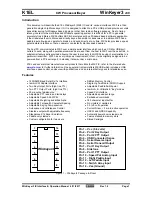
Chapter 5 Packet Operation
Note
: with each station connected to your node you’ll lose a “logical” channel. So, if you have
GUSERS
set
to
3
and three source stations have connected to three destination stations through your node, they’ll take up
six of your ten channels, leaving you with only four channels to accept and initiate contacts. (If a station
connects to your Maildrop that’d leave you three channels.)
Operating Your Node
Here’s what a user would see when using your node as a packet node. In this example, your
MYGATE
call is set to
N7ML-7
:
cmd:
C N7ML-7
*** CONNECTED to N7ML-7
+++ N7ML node. Type ? for help.
de N7ML-7 (B,C,D,J,L,N,S,?) >
The first line is the user’s connect request to your TNC. The second line is the connect message from the user’s
TNC. The third line is the greeting. And the fourth is the command prompt from the node. The user sends a question
mark,
?
,
to obtain the following help menu:
B(ye) Log off node
C(onnect) n Connect to station ’n’
C n STAY Stay connected to node when ’n’ disconnects
D(isconnect) Cancel a connect attempt
J(heard) Display stations heard
L(isten) Toggle monitoring
N(odes) Display nodes heard
S(end) Broadcast unproto
de N7ML-7 (B,C,D,J,L,N,S,?) >
The commands’ functions are:
B(ye)
This is similar to the Bye command used in the AEA Maildrop and BBS stations. When a user
enters a
B
the node will “disconnect.”
C(onnect)
n
Similar in operation to the
CONNECT
command in the packet mode. (Also used to connect in
AMTOR and PACTOR instead of using the
ARQ
and
PTCONN
commands, respectively.)
For a packet connection, the user may connect to your node, then specify a string of digipeaters:
C W1AW VIA W2XY, W1XXZ
Your node will try to establish a connection with W1AW as the destination; the user’s callsign
will be shown as the source but with a difference: the user’s SSID is decremented by one to avoid
protocol conflicts on the same frequency.
Here is an example of the frames sent in establishing a typical connection (with the
MONITOR
command set to
5
):
USER>GATE
[C]
GATE>USER
(UA)
GATE>USER
[I]:
+++ N7ML node. Type ? for help.
de GATE (B,C,D,J,L,N,S,?) >
USER>GATE
(RR)
USER>GATE
[I]:
c remote
GATE>USER (RR) USER-15>REMOTE [C]
REMOTE>USER-15 (UA)
GATE>USER
[I]:
+++ CONNECTED to REMOTE at GATE
USER>GATE
(RR)
USER>GATE
[I]:
hello.
September, 05
5-11
Summary of Contents for DSP-232
Page 120: ...Chapter 6 GPS Applications September 05 6 1...
Page 138: ...Chapter 7 Maildrop Operation 7 18 September 05...
Page 158: ......
Page 159: ...Chapter 8 ASCII and Baudot Operation September 05 8 1...
Page 185: ......
Page 186: ...Chapter 9 AMTOR Operation September 05 9 1...
Page 198: ......
Page 199: ...Chapter 10 Morse Operation September 05 10 1...
Page 207: ......
Page 208: ...Chapter 11 SIAM and NAVTEX Operation September 05 11 1...
Page 230: ......
Page 231: ...Chapter 12 PACTOR Operation September 05 12 1...
Page 240: ...Chapter 13 Troubleshooting September 05 13 9...
Page 254: ...Chapter 13 Troubleshooting 13 9...
Page 256: ...DSP 232 Manual Addendum September 05 AD 2...
Page 259: ...Appendix A Radio Connections Radio Connection Diagrams September 05 A 3...
Page 260: ...Appendix A Radio Connections A 4 September 05...
Page 261: ...Appendix A Radio Connections September 05 A 5...
Page 262: ...Appendix A Radio Connections A 6 September 05...
Page 263: ...Appendix A Radio Connections September 05 A 7...
Page 267: ...Appendix D Mailbox Upgrade September 05 D 2...
Page 268: ...Appendix E Schematics and Pictorial September 05 E 3...
















































